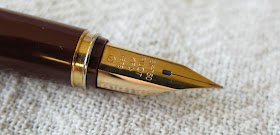Review of the Tombow Zoom 828 (1989).
Some days ago I spoke about a
jumbo pen presumably made by Platinum/Nakaya. As I already explained, jumbo pens were oversize in their girth and somehow short in their length. Although their golden age were the thirties and forties, they have been on production –sometimes as souvenirs— until recently. Such was the case, for instance, of the
Platinum Glamour from the 1980s.
Another example could be the pen under analysis today—the Tombow Zoom 828, also known as “the egg”. Tomow realeased writing tools with this shape in 1987, but the fountain pen had to wait until 1989. The original price was JPY 3500.

Tombow is a company very fond of new designs and of rethinking the form and use of writing utensils. Thus, very thin, or very short, or very thick pens could be found in
its catalog. In this task, Tombow has collaborated with a
number of designers well beyond the Japanese borders.
1. Appearance and design. (8.0/10)
This pen is a short and fat version of the stereotypical Montblanc torpedo. Its shape and size are unusual and many express their skepticism at its functionality. But that is the topic of another section of this review.
Suffice to say now that this design is an additional twist to a very traditional idea of a fountain pen.
2. Construction and quality. (7.5/10)
Some people might call this a “precious resin”, but at the end, it is plastic. This one in particular seems quite resistant to scratches. The golden coatings on clip and nib are disappearing. This pen, I must say, endured constant and heavy use during my college years.
So, I give it a 7.5 because it was not an expensive pen and it still works perfectly after years of heavy use—albeit cosmetically is quite worn.
 3. Weight and dimensions.
3. Weight and dimensions. (7.5/10)
This is the key point of this pen.
Diameter: 23 mm
Length capped: 110 mm
Length uncapped: 98 mm
Length posted: 135 mm
Weight: 32 g
Figure wise, this is a heavy pen. But being so short, the center of gravity is well between the grabbing fingers. Therefore, the balance of this pen is very good. The overall comfort, though, could be much better had the pen been longer or the posting system more secure. The grip, given its girth, is very comfortable.
4. Nib and writing performance. (8.0/10)
This is a steel nib, gold coated. A very smooth and rigid fine point. It is on the dry side, but nothing uncomfortable. Very constant and reliable flow.
 5. Filling system. Maintenance
5. Filling system. Maintenance. (8.0/10)
This pen uses international short cartridges. Some small aerometric converter might fit in, but I have not found it.
The barrel has a lot of empty space inside, and the short cartridge looks a bit ridiculous when attached to the pen. So, given this conditions, this pen could be a very good candidate for an eyedropper. The only problem is a metallic piece in the area of the nipple that could be corroded by the ink.
Maintenance is easy, as is the case with most cartridge/converter pens.
 6. Cost and value.
6. Cost and value. (8.5/10)
Not an expensive pen originally, and a good reliable writer make a good value. Nowadays, it has the additional element of the originality.
7. Conclusion. (47.5/60=79/100)
Original pen. Good and reliable writer. Correct, even if boring, nib.

(Tombow Zoom 828 – Waterman Havana)
Bruno Taut
(Inagi, September 10, 2010)
[labels: Tombow]
 From left to right, a cheap seal called mitome (認印) for informal occasions, the receipt of registration of the formal seal before the city hall, and my personal hanko, on the right.
From left to right, a cheap seal called mitome (認印) for informal occasions, the receipt of registration of the formal seal before the city hall, and my personal hanko, on the right. 

















































